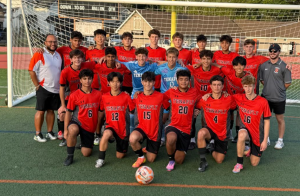Clubs Are Created, but Don’t Convene
November 14, 2018
Have you ever stopped to think about just how many clubs our school has? The Autism Club, Astronomy Club, Art Club, Chess Club, Film Club, History Competition Club, and the Math Club. And that’s just to name a few. In fact, our school has recently approved seven more clubs which were proposed by members of the student body at an S.O. meeting on Wednesday, October 17th: Operation Smile, Japanese Culture Club, Gardening Club, STEM Club, Podcast Club, Made with Love, and the Critics Club.
The school, after passing these seven clubs, now has a total 71 clubs. You can click here to view the complete list of clubs our school has to offer, not including the new ones which were just approved.
Now, this isn’t to say that we don’t love and appreciate all the clubs, both the old and newly created clubs, but just how many are actually regularly meeting? And how many are actually getting things done? It’s no secret that clubs are constantly being established at our school and not continuing to meet throughout the year, eventually dying out to the point where no one even knows if it’s a club anymore. Students who form brand new clubs or take on positions in pre-existing clubs often aren’t meeting as much as they promised they would when they proposed their club idea to the S.O. Many club leaders head clubs which simply don’t meet at all, aren’t productive with regard to the objective of their clubs, and fail to meet the expectations and responsibility that comes with their role.
Whether this is a long-time trend or a new phenomenon, the more important question is why. Could this be the result of the presumed laziness and irresponsibility of teenagers or the complete opposite? Are students taking on too many responsibilities and thus not dedicating enough time to their clubs? Do you know someone who is a member of or has a position in multiple clubs? Not that there’s anything wrong with that, but is that multi-club leader or member able to dedicate his or her time to each one, in addition to keeping up with his or her schoolwork? This also raises the question of why students join or form clubs in the first place. Are students thinking only of college admissions when they decide to join, propose, or take on a position of responsibility in a club, or are students signing up for clubs because they truly care about the clubs’ goals?
Many students and teachers agree that there need to be set rules and a specified list of consequences to prevent such events from occurring. But besides the risk of getting caught for dishonesty and a lack of integrity in the process of applying to colleges, which, according to Luke Smith, S.O. president (’19), “never happens,” there are no further consequences established for creating “paper clubs” at Tenafly High School. So what’s to stop students from repeatedly doing it? Perhaps if the student body and administration work alongside each other to establish rules regarding a club’s activity and protocols for students that break them, we can put an end to this corruption.
“We are unable to control whether or not students lie on their college app,” said S.O. Vice President, Abigail Pomerantz (’19). “It is unfair and dishonest, but students will do it no matter what. We cannot control students’ college apps, but we can potentially do something to be stricter about regulating clubs’ habits.”
According to one study conducted at the College at Brockport, extracurricular activity involvement was perceived to play a moderately important role. Additionally, admissions counselors identify that extracurricular activity involvement implies a student’s ability to be successful at a post-secondary institution.
The study found that participation in extracurricular activities had greater importance in the college admission decision than it did five years prior to another study. With increasing enrollment in post-secondary institutions across the country, many colleges are changing their admissions policies to place greater weight on personal qualities such as participation in extracurricular activities, which, the study found, is a desirable quality in any college-bound applicant.
Most clubs at THS meet once a week, but others meet less often, sometimes convening only once a month. That isn’t the problem, though, as some clubs don’t need as many meetings as others. “I do know some clubs that don’t meet that often but are still being productive and just don’t need as many meetings,” said Smith. “But there is a problem with clubs being approved and then becoming inactive. At the start of each year, we send a form to all clubs to fill out, and if a club has become inactive, they wouldn’t fill out the form and the club would be forgotten about unless someone tries to restart it.”
Our school needs to implement a plan of action to confront this problem. Whether it is the student body’s responsibility or the administration’s job is another story, but we can’t allow this to continue. Many S.O. representatives believe action should be taken. “We do not do anything to ensure that clubs meet regularly,” said Pomerantz. “However, I believe that we should be doing something because we have too many clubs that either overlap in purpose or that are created and then do not actively meet.”
The S.O. has attempted to resolve this issue before. A club oversight committee was once proposed but not established. “A few years ago, the S.O. attempted to make a committee that checked up on clubs to make sure that they were all active and accomplishing something,” said Pomerantz. “However, the committee never really did anything and eventually evaporated. We have discussed inactive clubs and may consider doing something to check up on clubs.”
Smith agrees. “This has been a long-lasting debate amongst the S.O. as we do find it to be an issue. As we discuss this further, we hope to find a solution that the administration is happy with and agrees with.”


















































































































































